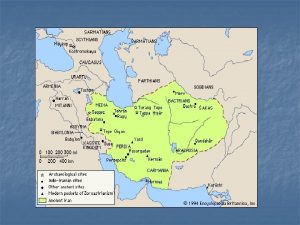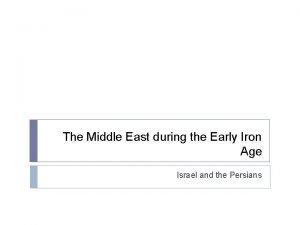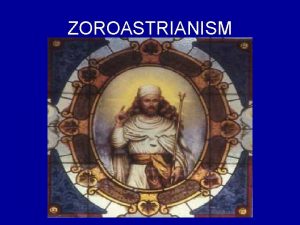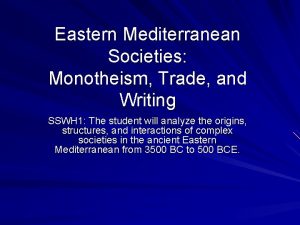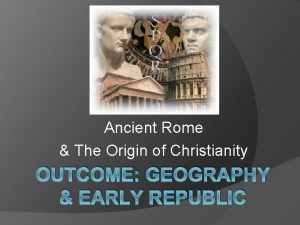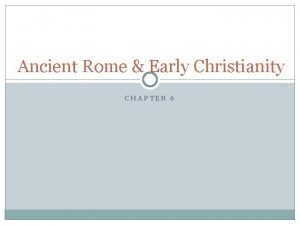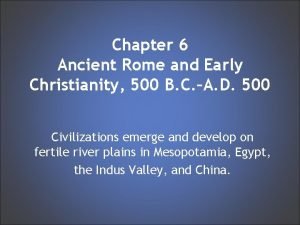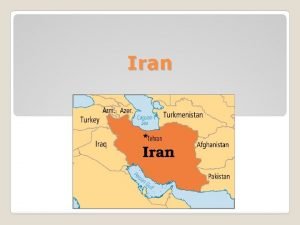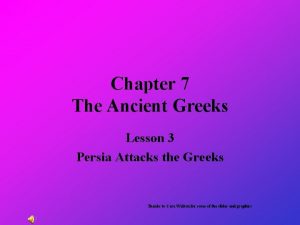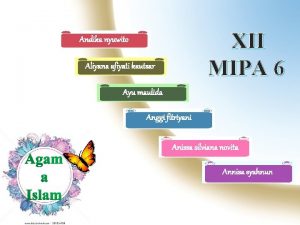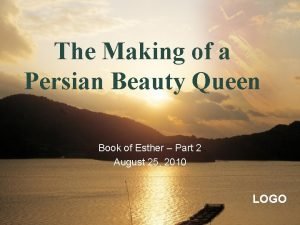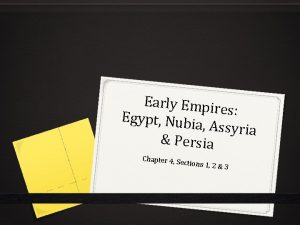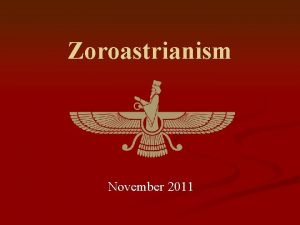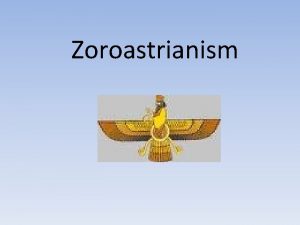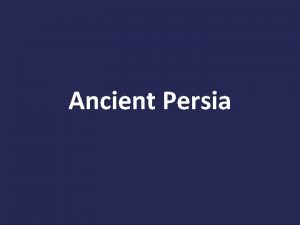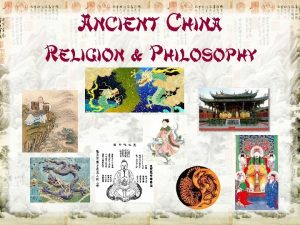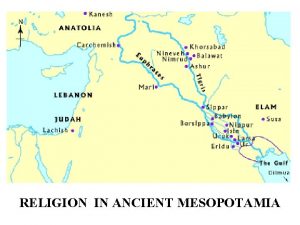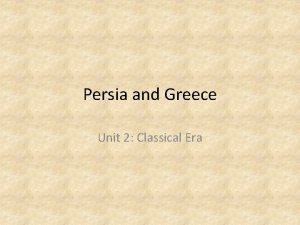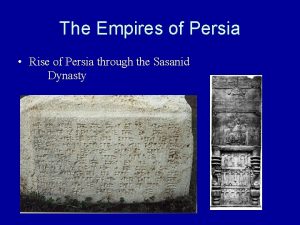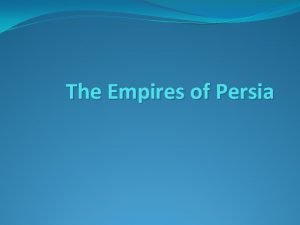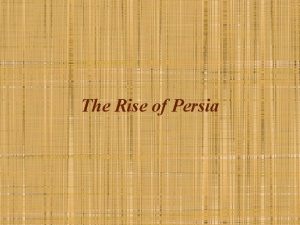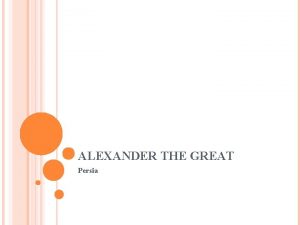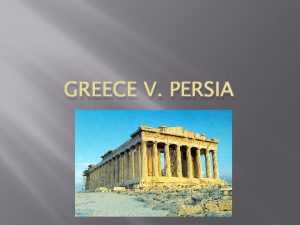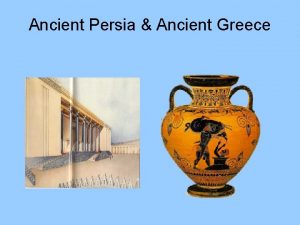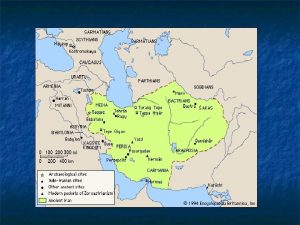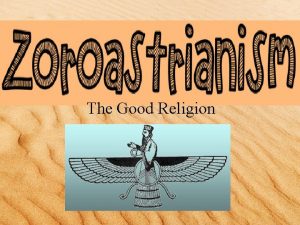Zoroastrianism The Ancient Religion of Persia Early Zarathushtra



























- Slides: 27

Zoroastrianism The Ancient Religion of Persia Early. Zarathushtra Iranian Religious (Zoroaster) Beliefs: Beliefs Eastern Iranian tribal, pastoral people • Prophetic reformer and founder in the second millennium BCE of the to Zoroastrian religion. adhered polytheistic Aryan folk religion, which combined • Lived between 1200 the andworship 600 of BCE gods of nature with a beliefinin a in Bactria, a territory rulingeastern cosmic. Iran moral law or order. or northern Afghanistan. • Zoroaster began preaching a religion of the one true God (ahura mazda) after receiving a divine vision from God.


The Achaemenid conquests Empire of Alexander (559 -330 Great BCE): (330 Zoroastrianism BCE) Sassanian Period (ca. 225 CE– –ca. 651 CE): Parthian Period (ca. 225 the BCE 225 CE): and his successors widespread (323 -225 indominant BCE). the Persian Hellenization Empire. of Iran. Zoroastrianism the religion of Persia, Zoroastrianism co-existed with other religious th century CE. until the Muslim conquests of the 7 traditions.

Zoroastrianism Through the Centuries

Zoroastrians today are found mainly in parts of Iran (Gabars) and India (Parsees). Zoroastrians today number between 140, 000 and 200, 000. 14 Million Jews 376 Million Buddhists 1. 3 900 2 Billion Million Christians Muslims Hindus

Why so few Zoroastrians? Belief in non-conversion to Zoroastrianism. Prohibition against intermarriage Children of all intermarriages are non-Zoroastrians.

Importance of Zoroastrianism 2000 BCE 1500 BCE Vedas Abraham 1000 BCE Upanishads Moses 500 BCE Common Era Begins Hebrew Scriptures Bhagavad Gita New Testament Buddha Jesus Hinduism Early Judaism 600 CE Koran Mohammad Buddhism Islam Christianity Second Temple Judaism Talmudic Judaism Zoroastrianism

Basic Zoroastrian Beliefs

Sacred Scriptures The Avesta (composed between the 3 rd and 7 th century CE). The Avesta includes the Yasna and the Yashts. The earliest portions of the Avesta (the Gathas of the Yasnas) contain content that likely predates the composition of the Avesta. The Gathas, largely in the form of hymns and rituals, probably originated from Zoroaster himself.

Monotheism The existence of a single personal God (Ahura Mazda, wise lord) who alone is worthy of worship. Ahura Mazda is the uncreated creator of the universe, the God of all gods. Pa nam i yazda Fravarane mazdayasno zarathushtrish vidaevo ahura-tkaesho. In the name of God I profess myself a Mazda-worshipper and a Zoroastrian, opposing the Daevas and accepting the Ahuric doctrine.

Cosmic Dualism There is a cosmic struggle between Good and Evil, between the truth (asha) and the lie (druj), an on-going war between the evil spirit Angra Mainyu and the good spirit Spenta Mainyu. Both are sons of Ahura Mazda.

History Age of Creation Period of Good and Evil Day of Final Judgment At present we live in the period of good and evil. In the cosmos and on earth, there is a perpetual conflict between good and evil. Ahura Mazda will defeat the forces of evil on the day of judgment. Just before the coming day of final judgment there will arise a savior (saoshyant) who will convert many to Zoroastrianism.

Salvation • Each person experiences a conflict between good and evil. • Since each freely chooses between good and evil, each person is accountable for his or her life. • One’s deeds (good or evil) are ultimately judged by Ahura Mazda after death. • After death, while the body decays, one’s soul (urvan) either enters a heavenly paradise or a place of punishment.

• The unrighteous suffer punishment in hell until the day of final judgment, at which time they are reunited to their bodies to live eternally at peace with God. • Hell is not eternal. It is a temporary place in which unrighteous souls experience moral purification. • The souls that immediately entered heaven at death are also reunited with their resurrected bodies. • The entire human race enjoys eternal happiness in a universe that has been restored to pure goodness.

Zoroastrian Practices

Worship of Ahura Mazda takes place in a firetemple, a place of worship where a fire burns continuously – a symbol of Ahura Mazda.

Five daily prayers and water cleansings are important Zoroastrian rituals. Interior of Zoroastrian temple (right). Dates from the Achaemenid Period. 6 th century BCE to 4 th century BCE

Tower of Silence The dead are neither buried nor cremated. They are placed in stone, open-air structures, where the bodies are left exposed to sunlight and vultures.

Zoroastrian Symbolism Fravashi or Fravahar “Good thoughts, Good words, Good Deeds” Three Rows of Feathers Upper Wings Three Rows of Feathers Lower Wings

Zoroastrian View of the Afterlife A Closer Examination

Personal Eschatology: The Fate of the Person Immediately after Death Humans are transformed into an immortal soul (urvan) at the time of death and receive reward or punishment for their deeds. Urvan is not an individual’s personality, but an aspect of the former individual personality, the moral core of personality. After lingering around the corpse for three days, the urvan passes over into the next life, where the good person is greeted by a lovely young woman (Daena) and the bad person is greeted by the demon (Vizaresha).

30. 'Then comes the beautiful, well-shapen, strong and well-formed maid 52, with the dogs at her sides 53, one who can distinguish 54, who has many children 55, happy, and of high understanding. 'She makes the soul of the righteous one go up above the Hara-berezaiti 56; above the Chinwad bridge she places it in the presence of the heavenly gods themselves. ” (Vendidad 30)

Daena and Vizaresha are personifications of the moral qualities of the person. (cf. Chonyid Bardo in Buddhism) The Judgment. . Each person undergoes individual judgment at the Chinvat Bridge, a bridge that stretches over hell and connects earth and heaven. As each person’s deeds are read, their crossing is made easy or difficult. The bridge widens or becomes thin as a knife blade. The wicked fall into hell. The righteous are guided to paradise by Daena or Zoroaster.

(55) The body is mortal but the soul is immortal. Do good works, for the soul is (real), not the body, the next world is (real), not this world. (56) Do not abandon the care of the soul and forget it for the body's sake. (57) Out of respect for persons (and out of forgetfulness) that all the goods of this world must perish, do not lust after anything that will bring punishment on your body and retribution on your soul. Desire rather those things whose fruit is an everlasting joy. ” Zoroastrian Catechism

General Eschatology: The Collective Judgment of the Human Race There is a universal physical resurrection of all humanity at the end of time (general eschatology) when Ahura Mazda defeats all the forces of evil. He then judges the entire human race. “The dead will rise in their lifeless bodies. ” (Yasna 54) As part of the universal judgment, everyone must pass through a pouring molten metal. This will be a pleasant experience for the righteous (like taking a warm shower), but a painful experience for the wicked (like being burned alive).

The suffering of the wicked in the hell of molten metal lasts only three days. Ultimately, this universal cleansing permits all people to achieve salvation. Zoroastrianism holds to universalism, the view that everyone is eventually redeemed. Hell for the wicked is thus only a purgatorial realm. On the final day of judgment, the world is not destroyed. It is restored and all humans inherit the earth and live forever in prosperity.

 Mazdaism religion
Mazdaism religion Afterlife in zoroastrianism
Afterlife in zoroastrianism Zoroastrian beliefs
Zoroastrian beliefs Zoroastrianism teaching
Zoroastrianism teaching Ushta zoroastrianism
Ushta zoroastrianism Good deeds good words good thoughts
Good deeds good words good thoughts Zoroastrianism
Zoroastrianism Zoroastrianism major beliefs
Zoroastrianism major beliefs Western religion vs eastern religion
Western religion vs eastern religion Spartan religious festivals
Spartan religious festivals 221 ad
221 ad Early cpr and early defibrillation can: *
Early cpr and early defibrillation can: * Ancient rome outcomes geography and early republic
Ancient rome outcomes geography and early republic Early empires in the ancient near east
Early empires in the ancient near east Chapter 6 ancient rome and early christianity
Chapter 6 ancient rome and early christianity Chapter 9 lesson 1 early civilizations
Chapter 9 lesson 1 early civilizations Ancient rome and early christianity chapter 6
Ancient rome and early christianity chapter 6 Ancient india vs ancient china
Ancient india vs ancient china Ancient ways of communication
Ancient ways of communication Iran before 1935
Iran before 1935 Babilonia medo persia grecia roma
Babilonia medo persia grecia roma Where was oil first discovered
Where was oil first discovered Persia antica
Persia antica عبدل آباد
عبدل آباد Lesson 3 greece and persia
Lesson 3 greece and persia Teori mekah
Teori mekah Persia beauty queen
Persia beauty queen Cambysus
Cambysus
